#greek and roman mythology
Text
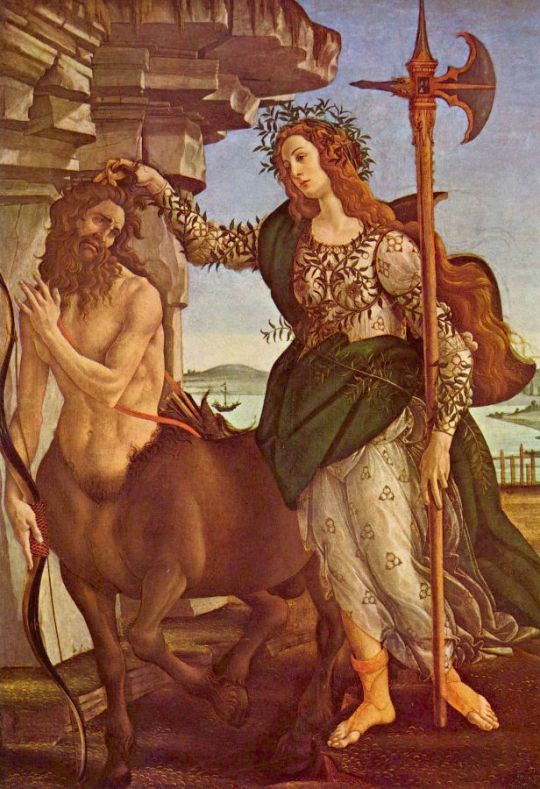
Sandro Botticelli (Italian, c. 1445-1510) • Pallas and Centaur • c. 1482 • Tempera on canvas • Uffizi, Florence
#art#painting#fine art#art history#botticelli#italian renaissance#italian artist#greek and roman mythology#mythological painting#centaurs in artworks#tempera on canvas#tempera painting#pagan sphinx art blog#Rrenaissance art
29 notes
·
View notes
Text
percy “if i could be anyone dead or alive, i would want to be my dad in 1985” jackson
#percy jackson and the heroes of olympus#percy jackson#percy jackson pjo#percy jackson incorrect quotes#annabeth percy jackson#annabeth chase#heroes of olympus#pjo series#nico di angelo#will solace#rick rordian#uncle rick#rordianverse#posideon#greek and roman mythology#jason grace#percabeth#percy jackson and the olympians#camp halfblood#camp jupiter#new Rome#long island sound
179 notes
·
View notes
Text
☆*:Fade Into You:*☆
warnings: Apollo x GN! Reader, reader is tatted, nothing much no language just fluff ♡
Laying atop of your lovers plush olympian bedding staring at the stories painted on the walls, some weaved into fabricated art so clearly that it looked as if the moments were playing out in front of you. As you stretched your arms out loosely searching for your lover- one arm draped itself over the edge of the absurdly large bed whilst the other pawed along the mattress yearning for the touch and heat of your beloved soon to be husband-the silk sheets that once covered your upper body slowly creeped its way down your torso, exposing your chest. Letting out a large, dramatic yawn you arch your back then drop your body just as dramatically down to the awaiting covers. The satisfying stretch left a tingling sensation running up your spine, weaving through your bones and blood, wafting under the flesh of your arms. Satiated with the feeling but mourning the absence of your partner you decided to savor his spot in bed. Rolling over onto your side and placing your arm that was once draped off the bed over his pillow- noting that it was still warm- leaning to his side of the bed you plopped yourself face first into the gold, silk pillows, white lace lining the edges in small delicate patterns.
It still smelled like him too.
Taking a moment to inhale the honeycomb like scent, you smile to yourself
The bed still lingered of his heat and scent, he must be rising the sun, he wont be long.
You decided to sleep until Apollos return shutting your eyes and concentrating on your breathing, until you felt soft fingers languidly caressing the inked flesh on your back.
Up and down, tracing the patterns of your tattoo, then over again.
He wanted you to acknowledge him first, you knew that good and well, but you put up a good pettyfight. Hugging onto his pillow and sealing your eyes closed even tighter than before. You would have won this battle, you really truly would’ve, but as soon as he sat the weight of his body on the mattress pressing his knees into the mattress space next to the small of your back you had no choice but to fall over. Toppling over into his lap still holding onto his pillow.
Finally you opened your eyes to look up at your lovers face- you smiled. You didn’t need a reason to smile at Apollo you just did. Maybe it was because of his beauty, or maybe the charismatic personality that shone through his skin- you’re not very sure, but you were sure of how happy he made you.
You need not speak, words weren’t required for your eyes would tell him everything. Though he could not hear you, he saw it, through you- your happiness showing through your skin, projecting an aura of light around you.
And in this very moment Apollo knew that you were the being he wanted to spend all of eternity with.
*・゜゚・*:.。..。.:*・'*゚*'・*:.。. .。.:*・゜゚・**・゜゚・'.。.:*・゜゚・*
Idk if the ppl from my Bela Ramsey x reader stuff want to be tagged in these kinda posts so im not gonna tag them unless they tell me otherwise 💀
#apollo#apollo x reader#greek gods#greek myth#blood of zeus#percy jackson#greek and roman mythology#apollo greek god#apollo greek mythology
147 notes
·
View notes
Photo

“Seated Apollo” with a lyre, red porphyry and white marble, 2nd century CE
A few sources identify this as a statue of the goddess Rome that was renamed “Seated Apollo” after a 19th century restoration.
Photo by Charles Reeza at the National Archaeological Museum, Naples
#red porphyry#ancient art#stone carving#Greek and Roman mythology#deities#Farnese collection#Napoli#Italy
191 notes
·
View notes
Text




Greek + Roman sculpture at the Met xx
#my photos#the metropolitan museum of art#art museum#ancient greek#ancient rome#the met#nyc#new york#greek and roman mythology#ancient art#sculpture#art history#western art history#mine#art#photography#museum#new york city#architecture detail#dark academia#light academia#dark academia aesthetic#light academia aesthetic#academia aesthetic#ancient greece#antiquities#travel#queue
34 notes
·
View notes
Text
is achilles a nepo baby? discuss.
2 notes
·
View notes
Text
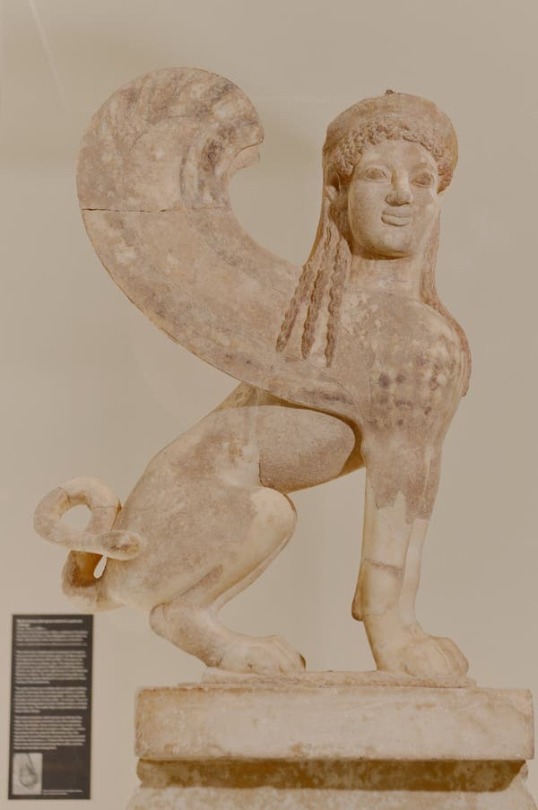

However, some historians worry that the Met Museum has elevated the increasingly ubiquitous Brinkmann replicas to an iconic status that is becoming the default representation of ancient polychromy, when the couple’s research is just one among dozens of competing theories.
A lifetime of persistence has afforded the Brinkmann replicas a celebrity status that can eclipse the genuine artifacts; their reconstructions have been shown as definitive representations of the past in Wikipedia articles and in big-budget video games like Assassin’s Creed Odyssey, which takes place in ancient Greece.
However, of 10 scholars interviewed for this article, more than half said that the Brinkmanns have taken a heavy-handed approach to painting, choosing excessively bright hues that leave their reconstructions looking gaudy. One criticism is that the pair ignored elements of lighting and fading that artists of the era would have anticipated in their work.
5 notes
·
View notes
Text
I love you people going into "useless" fields I love you classics majors I love you cultural studies majors I love you comparative literature majors I love you film studies majors I love you near eastern religions majors I love you Greek, Latin, and Hebrew majors I love you ethnic studies I love you people going into any and all small field that isn't considered lucrative in our rotting capitalist society please never stop keeping the sacred flame of knowledge for the sake of knowledge and understanding humanity and not merely for the sake of money alive
#classics#mythology#ancient greek mythology#ancient roman mythology#comparative literature#latin#hebrew#ethnic studies#fuck capitalism#communism#i love my useless degree idc#academia#university#dark academia#Greek#philosophy#liberal arts#humanities#women and gender studies#cultural anthropology
35K notes
·
View notes
Note
One LO head-canon I have is that original Roman gods like Janus, Juturna, Pomona, Feronia and Terminus are just greek gods born during the Roman Empire <3
Zeus: ah yes. The Rome bunch.
Zeus: actually, the gods are connected to the land, so they are, by all means "full roman".
Zeus: in any case, the majority of roman gods are just greek that got a larger influence ratius.
0 notes
Text
Reading the Iliad again
Tonight I finished The Iliad again. I started this trip through Homer’s grand war epic at the end of January, so it took me a little over 5 months to get through. While I read The Lost Tales of Sir Galahad along the way, the main consumer of my time away from my day job was teaching a swathe of Greek Fathers and then Augustine’s City of God. It doesn’t strike me as unreasonable to take this long,…

View On WordPress
0 notes
Text
The truth about Medusa and her rape... Mythology breakdown time!
With the recent release of the Percy Jackson television series, Tumblr is bursting with mythological posts, and the apparition of Medusa the Gorgon has been the object of numerous talks throughout this website… Including more and more spreading of misinformation, and more debates about what is the “true” version of Medusa’s backstory.
Already let us make that clear: the idea that Medusa was actually “blessed” or “gifted” by Athena her petrifying gaze/snake-hair curse is to my knowledge not at all part of the Antique world. I still do not know exactly where this comes from, but I am aware of no Greek or Roman texts that talked about this – so it seems definitively a modern invention. After all, the figure of Medusa and her entire myth has been taken part, reinterpreted and modified by numerous modern women, feminist activist, feminist movements or artists engaged in the topic of women’s life and social conditions – most notably Medusa becoming the “symbol of raped women’ wrath and fury”. It is an interesting reading and a fascinating update of the ancient texts, and it is a worthy take on its own time and context – but today we are not talking about the posterity, reinvention and continuity of Medusa as a myth and a symbol. I want to clarify some points about the ACTUAL myth or legend of Medusa – the original tale, as told by the Greeks and then by the Romans.
Most specifically the question: Was Medusa raped?
Step 1: Yes, but no.
The backstory of Medusa you will find very often today, ranging from mythology manuals (vulgarization manuals of course) to Youtube videos, goes as such: Medusa was a priestess of Athena who got raped by Poseidon while in Athena’s temple, and as a result of this, Athena punished Medusa by turning her into the monstrous Gorgon.
Some will go even further claiming Athena’s “curse” wasn’t a punishment but a “gift” or blessing – and again, I don’t know where this comes from and nobody seems to be able to give me any reliable source for that, so… Let’s put this out of there.
Now this backstory – famous and popular enough to get into Riodan’s book series for example – is partially true. There are some elements here very wrong – and by wrong I do mean wrong.
The story of Medusa being raped and turned into a monster due to being raped does indeed exist, and it is the most famous and widespread of all the Medusa stories, the one people remembered for the longest time and wrote and illustrated the most about. Hence why Medusa became in the 20th century this very important cultural symbol tied to rape and the abuse of women and victim-blaming. HOWEVER – the origin of this story is Ovid’s Metamorphoses, from the first century CE or so. Ovid? A Roman poet writing for Roman people. “Metamorphoses”? One of the two fundamental works of Roman literature and one of the two main texts of Roman mythology, alongside Virgil’s Aeneid. This is a purely Roman story belonging to the Roman culture – and not the Greek one. The story of Medusa’s rape does not have Greek precedents to my knowledge, Ovid introduced the element of rape – which is no surprise given Ovid turned half of the romances of Greek mythology into rapes. Note that, on top of all this, Ovid wasn’t even writing for religious purposes, nor was his text an actual mythological effort – he wrote it with pure literary intentions at heart. It is just a piece of poetry and literature taking inspiration from the legends of the Greek world, not some sort of sacred text.
Second big point: The legend I summarized above? It isn’t even the story Ovid wrote, since there are a lot of elements that do not come from Ovid’s retelling of the story (book fourth of the Metamorphoses). For example Ovid never said Medusa was a priestess of Athena – all he said was that she was raped in the temple of Athena. I shouldn’t even be writing Athena since again, this is a Roman text: we are speaking of Minerva here, and of Neptune, not of Athena or Poseidon. Similarly, Minerva’s curse did not involve the petrifying gaze – rather all Ovid wrote about was that Minerva turned Medusa’s hair into snakes, to “punish” her because her hair were very beautiful, and it was what made her have many suitors (none of which she wanted to marry apparently), and it is also implied it is what made Neptune fall in love (or rather fall in lust) with her. I guess it is from this detail that the reading of “Athena’s curse was a gift” comes from – even though this story also clearly does victim-blaming of rape here.
But what is very fascinating is that… we are not definitively sure Neptune raped Medusa in Ovid’s retelling. For sure, the terms used by Ovid in his fourth book of Metamorphoses are clear: this was an action of violating, sexually assaulting, of soiling and corrupting, we are talking about rape. But Ovid refers several other times to Medusa in his other books, sometimes adding details the fourth-book stories does not have (the sixth book for examples evokes how Neptune turned into a bird to seduce Medusa, which is completely absent from the fourth book’s retelling of Medusa’ curse). And in all those other mentions, the terms to designate the relationship between Medusa and Neptune are more ambiguous, evoking seduction and romance rather than physical or sexual assault. (It does not help that Ovid has an habit of constantly confusing consensual and non-consensual sex in his poems, meaning that a rape in one book can turn into a romance in another, or reversal)
But the latter fact makes more sense when you recall that the rape element was invented and added by Ovid. Before, yes Poseidon and Medusa loved each other, but it was a pure romance, or at least a consensual one-night. Heck, if we go back to the oldest records of the love between Poseidon and Medusa, back in Hesiod’s Theogony, we have descriptions of the two of them laying together in a beautiful, flowery meadow – a stereotypical scene of pastoral romances – with no mention of any brutality or violence of any sort. As a result, it makes sense the original “romantic” story would still “leak” or cast a shadow over Ovid’s reinvented and slightly-confused tale.
Step 2: So… no rape?
Well, if we go by Greek texts, no, apparently Medusa was not raped in Greek mythology, and only became a rape victim through Ovid.
The Ancient Greek texts all record Poseidon and Medusa sleeping with each other and having children, but no mention of rape. And the whole “curse of Athena” thing is not present in the oldest records – no temple of Athena soiling, no angry Athena cursing a poor girl… “No curse?” you say “But then how did Medusa got turned into a Gorgon”? Answer: she did not. She was born like that.
As I said before, the oldest record of Medusa’s romance but also of her family comes from Hesiod’s Theogony (Hesiod being one of the two “founding authors” of Greek mythology, alongside Homer – Homer did wrote several times about Medusa, but only as a disembodied head and as a monster already dead, so we don’t have any information about her life). And what do we learn? That Medusa is part of a set of three sisters known as the Gorgons – because oh yes, Ovid did not mention Medusa’s sister now did he? How did Medusa’s sisters ALSO got snake-hair or petrifying-gaze if only Medusa was cursed for sleeping with Neptune? Ovid does not give us any answer because again, it is an “adaptational plot hole”, and the people that try to adapt Ovid’s story have to deal with the slight problem of Stheno and Euryale needing to share their sister’s curse despite seemingly not being involved in the whole Neptune business. Anyway, back to the Greek text.
So, you have those three Gorgon sisters, and Medusa is said to be mortal while her sisters are not. Why is it such a big deal? Because Medusa wasn’t originally some random human or priestess. Oh no! Who were the Gorgons’ parents? Phorcys and Keto/Ceto, aka two sea-gods. Not just two sea-gods – two sea-gods of the ancient, primordial generation of sea-gods, the one that predated Poseidon, and that were cousins to the Titans, the sea-gods born of Gaia mating with Pontos.
So the Gorgons were “divine” of nature – and this is why Medusa being a mortal was considered to be a MASSIVE problem and handicap for her, an abnormal thing for the daughter of two deities. But let’s dig a bit further… Who were Phorcys and Ceto? Long story short: in Greek mythology, they were considered to be sea-equivalents of Typhon and Gaia. They were the parents of many monsters and many sea-horrors: Keto/Ceto herself had her name attributed and equated with any very large creature (like whales) or any terrifying monster (like dragons) from the sea. The Gorgons themselves was a trio of monsters, but their sisters, that directly act as their double in the myth of Perseus? The Graiai – the monstrous trio of old women sharing one eye and one tooth. Hesiod also drops the fact that Ladon (the dragon that guarded the golden apples of the Hesperids), and Echidna (the snake-woman that mated with Typhon and became known as the “mother of monsters”) were also children of Phorcys and Ceto, while other authors will add other monster-related characters such as Scylla (of Charybdis and Scylla fame), the sirens, or Thoosa (the mother of Polyphemus the cyclop). Medusa herself is technically a “mother of monsters” since she birthed both Pegasus the flying horse and Chrysaor, a giant. So here is something very important to get: Medusa, and the Gorgons, were part of a family of monsters. Couple that with the absence of any mention of curses in these ancient texts, and everything is clear.
Originally Medusa was not a woman cursed to become a monster: she was born a monster, part of a group of monster siblings, birthed by monster-creating deities, and she belonged to the world of the “primordial abominations from the sea”, and the pre-Olympian threats, the remnants of the primordial chaos. It is no surprise that the Gorgons were said to live at the edge of the very known world, in the last patch of land before the end of the universe – in the most inhuman, primitive and liminal area possible. They were full-on monsters!
Now you might ask why Poseidon would sleep with a horrible monster, especially when you recall that the Greeks loved to depict the Gorgons as truly bizarre and grotesque. It wasn’t just snake-hair and petrifying gaze: they had boar tusks, and metallic claws, and bloated eyes, and a long tongue that constantly hanged down their bearded chin, and very large heads – some very old depictions even show her with a female centaur body! In fact, the ancient texts imply that it wasn’t so much the Gorgon’s gaze or eyes that had the power to turn people into stone – but that rather the Gorgon was just so hideous and so terrifying to look at people froze in terror – and then literally turned into stone out of fear and disgust. We are talking Lovecraftian level of eldritch horror here. So why would Poseidon, an Olympian god, sleep with one of these horrors? Well… If you know your Poseidon it wouldn’t surprise you too much because Poseidon had a thing for monsters. As a sort of “dark double” of Zeus, whereas Zeus fell in love with beautiful princesses and noble queens and birthed great gods and brave heroes, Poseidon was more about getting freaky with all sorts of unusual and bizarre goddesses, and giving birth to bandits and monsters. A good chunk of the villains of Greek mythology were born out of Poseidon’s loins: Polyphemus, Antaios, Orion, Charybdis, the Aloads… And even his most benevolent offspring has freaky stuff about it – Proteus the shapeshifter or Triton half-man half-fish… So yes, Poseidon sleeping with an abominable Gorgon is not so much out of character.
Step 3: The missing link
Now that we established what Medusa started out as, and what she ended up as… We need to evoke the evolution from point Hesiod to point Ovid, because while people summarized the Medusa debate as “Sea-born monster VS raped and punished woman”, there is a third element needed to understand this whole situation…
Yes Ovid did invent the rape. But he did not invent the idea that Medusa had been cursed by Athena.
The “gorgoneion” – the visual and artistic motif of the Gorgon’s head – was, as I said, a grotesque and monstrous face used to invoke fright into the enemies or to repel any vile influence or wicked spirit by the principle of “What’s the best way to repel bad stuff? Badder stuff”. Your Gorgon was your gargoyle, with all the hideous traits I described before – represented in front (unlike all the other side-portraits of gods and heroes), with the face being very large and flat, a big tongue out of a tusked-mouth, snake-hair, bulging crazy eyes, sometimes a beard or scales… Pure monster. But then… from the fifth century BCE to the second century BCE we see a slow evolution of the “gorgoneion” in art. Slowly the grotesque elements disappear, and the Gorgon’s face becomes… a regular, human face. Even more: it even becomes a pretty woman’s face! But with snakes instead of hair. As such, the idea that Medusa was a gorgeous woman who just had snakes and cursed-eyes DOES come from Ancient Greece – and existed well before Ovid wrote his rape story.
But what was the reason behind this change?
Well, we have to look at the Roman era again. Ovid’s tale of Medusa being cursed for her rape at the hands of Neptune had to rival with another record collected by a Greek author Apollodorus, or Pseudo-Apollodorus, in his Bibliotheca. In this collection of Greek myths, Apollodorus writes that indeed, Medusa was cursed by Athena to have her beautiful hair that seduced everybody be turned into snakes… But it wasn’t because of any rape or forbidden romance, no. It was just because Medusa was a very vain woman who liked to brag about her beauty and hair – and had the foolish idea of saying her hair looked better than Athena’s. (If you recall tales such as Arachne’s or the Judgement of Paris, you will know that despite Athena being wise and clever, one of her main flaws is her vanity).
“Wait a minute,” you are going to tell me, “The Bibliotheca was created in the second century CE! Well after Greece became part of the Roman Empire, and after Ovid’s Metamorphoses became a huge success! It isn’t a true Greek myth, it is just Ovid’s tale being projected here…” And people did agree for a time… Until it was discovered, in the scholias placed around the texts of Apollonios of Rhodes, that an author of the fifth century BCE named Pherecyde HAD recorded in his time a version of Medusa’s legend where she had been cursed into becoming an ugly monster as punishment for her vanity. We apparently do not have the original text of Pherecyde, but the many scholias referring to this lost piece are very clear about this. This means that the story that Apollodorus recorded isn’t a “novelty”, but rather the latest record of an older tradition going back to the fifth century BCE… THE SAME CENTURY THAT THE GORGONEION STARTED LOSING THEIR GROTESQUE, and that the face of Medusa started becoming more human in art.
[EDIT: I also forgot to add that this evolution of Medusa is also proved by strange literary elements, such as Pindar's mention in a poem of his (around 490 BCE) of "fair-cheeked Medusa". A description which seems strange given how Medusa used to be depicted as the epitome of ugliness... But that makes sense if the "cursed beauty" version of the myth had been going around at the time!]
And thus it is all connected and explained. Ovid did invent the rape yes – but he did not invent the idea of Athena cursing Medusa. It pre-existed as the most “recent” and dominating legend in Ancient Greece, having overshadowed by Ovid’s time the oldest Hesiodic records of Medusa being born a monster. So what Ovid did wasn’t completely create a new story out of nowhere, but twist the Greek traditions of Athena cursing Medusa and Medusa having a relationship with Poseidon, so that the two legends would form one and same story. And this explains in retrospect why Ovid focuses so much on describing Medusa’s beautiful hair, and why Ovid’s Minerva would think turning her hair into snake would be a “punishment fit for the crime”: these are leftovers of the Greek tale where Medusa was punished for her boasting and her vanity.
CONCLUSION
Here is the simplified chronology of how Medusa’s evolution went.
A) Primitive Greek myths, Hesiodic tradition: Born a monster out of a family of sea-monsters and monstrous immortals. Is a grotesque, gargoylesque, eldritch abomination. Athena has only an indirect conflict with her, due to being Perseus’ “fairy godmother”. Has a lovely romance with Poseidon.
B) Slow evolution throughout Classical Greece and further: Medusa becomes a beautiful, human-looking girl that was cursed to have snake for hair and petrifying eyes, instead of being a Lovecraftian horror people could not gaze upon. Her conflict with Athena becomes direct, as it is Athena that cursed her due to being offended by her vain boasting. Her punishment is for her vanity and arrogant comparison to the goddess.
C) Ovid comes in: Medusa’s romance with Poseidon becomes a rape, and she is now punished for having been raped inside Athena’s temple.
[As a final note, I want to insist upon the fact that the story of Medusa being raped is not less "worthy" than any other version of the myth. Due to its enormous popularity, how it shaped the figure of Medusa throughout the centuries, and how it still survives today and echoes current-day problems, to try to deny the valid place of this story in the world of myths and legends would be foolish. HOWEVER it is important to place back things in their context, to recognize that it is not the ONLY tale of Medusa, that it was NOT part of Greek mythology, but rather of Roman legends - and let us all always remember this time Poseidon slept with a Lovecraftian horror because my guy is kinky.]
EDIT:
For illustration, I will place here visuals showing how the Ancient art evolved alongside Medusa's story.
Before the 5th century BCE: Medusa is a full-on monster



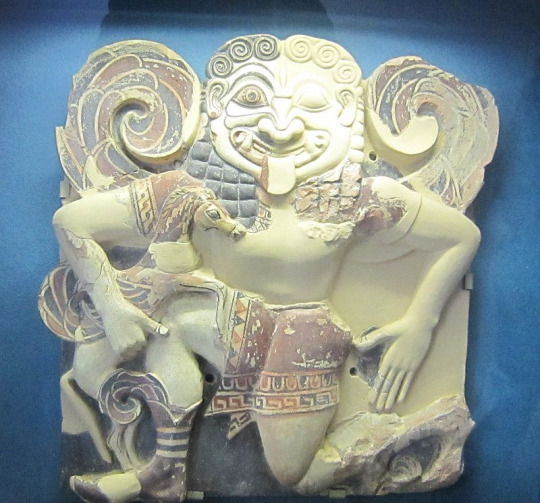

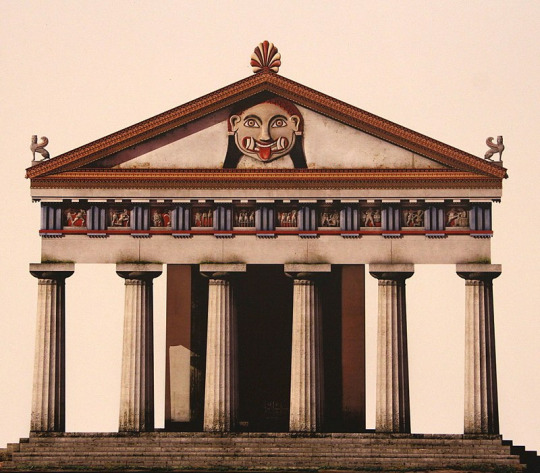
From the 5th century to the 2nd century BCE: A slow evolution as Medusa goes from a full-on monster to a human turned into a monster. As a result the two depictions of the grotesque and beautiful gorgoneion coexist.
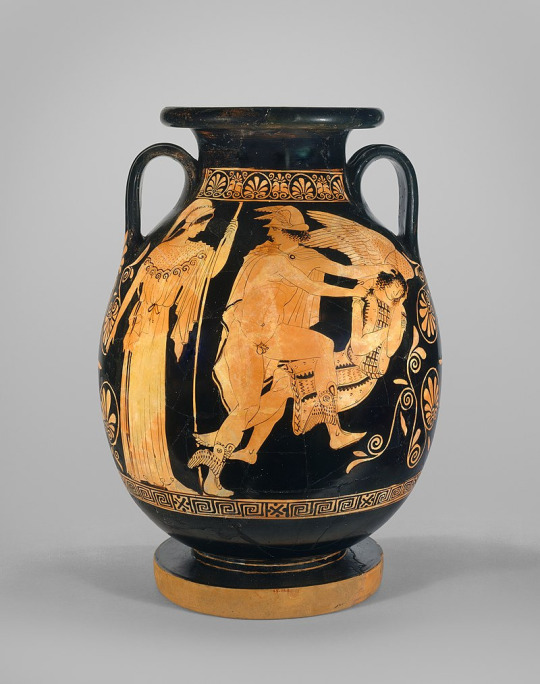


Post 2nd century BCE: Medusa is now a human with snake hair, and just that


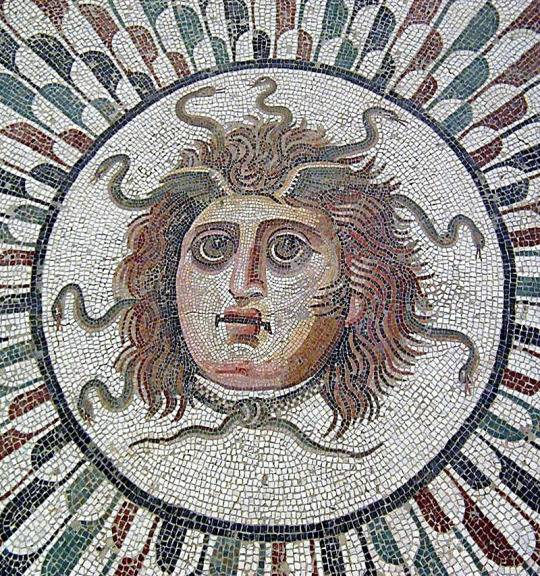
#greek mythology#medusa#gorgon#athena#gorgons#poseidon#neptune#minerva#ovid#rape in mythology#greek monsters#roman mythology
4K notes
·
View notes
Text
So in the context of Greek mythology the tripod is a special three legged stool that the oracle of Delphi sat on when she gave her prophecies. The stool itself was sacred. Very important.
And. There’s a myth where Heracles goes to the oracle of Delphi to ask a question of how to atone for something he did and the Oracle is like “I dunno dude figure it out yourself” and Heracles is so mad about this that he steals the tripod and Apollo himself is like “NO NOT MY TRIPOD” and comes down to snatch it back from him.
Now this is one of those myths that isn’t sourced in a lot of places. Pretty much only The Library by pseudo-Apollodorus I think? But we know it was a very popular and well known myth because artists really really liked painting and sculpting it

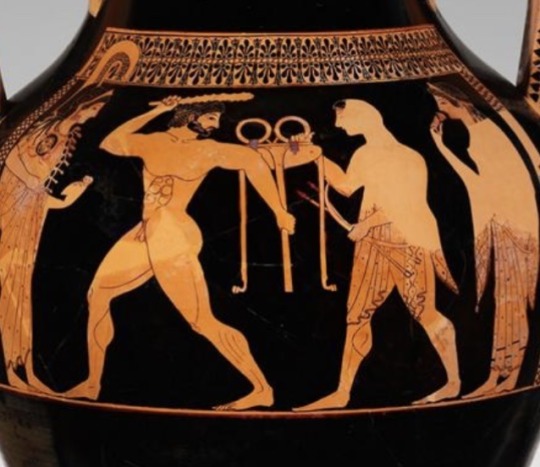


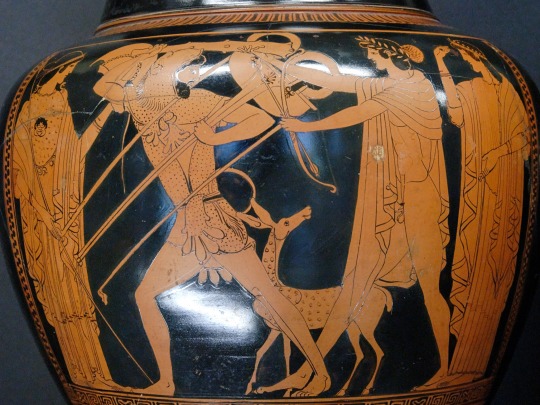
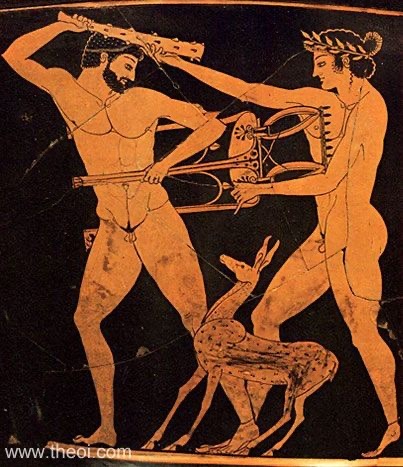
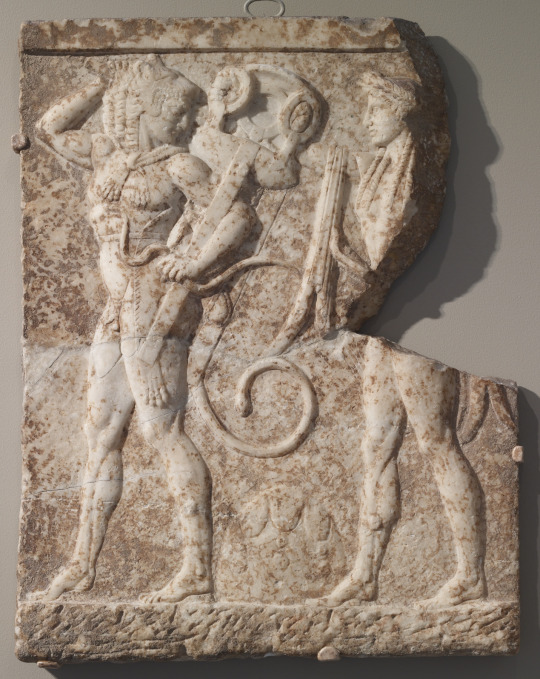
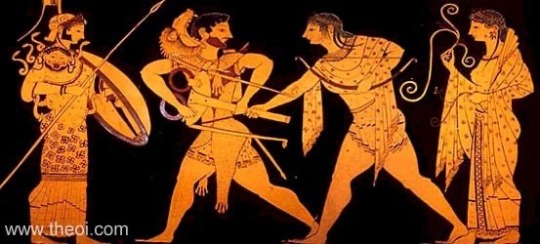

Look at him he’s like bro give it back seriously that’s my chair what do you think you’re doing
#roman said a thing#greek mythology#don’t nuke this one tumblr I swear to sweet baby Jesus this is pottery
8K notes
·
View notes
Text
Iconoclasm: The destruction of God/Goddess statues, figurines & paintings
Why do so many statues have broken noses, body parts ECT This is a question that a lot of people have asked. If you have ever visited a museum, you have probably seen ancient sculptures such as the one below—a Greek marble head of the poet Sappho currently held in the Glyptothek in Munich, with a missing nose:
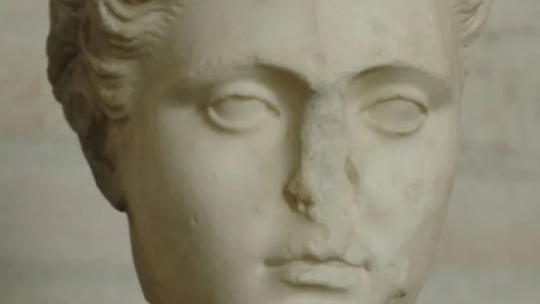
Bibi Saint-Pol, Public Domain, Wikimedia Commons
A smashed or missing nose is a common feature on ancient sculptures from all cultures and all time periods of ancient history. It is by no means a feature that is confined to sculptures of any particular culture or era. Even the nose on the Great Sphinx, which stands on the Giza Plateau in Egypt alongside the great pyramids, is famously missing:

If you have seen one of these sculptures, you have probably wondered: “What happened to the nose?” Some people seem to have a false impression that the noses on the majority of these sculptures were deliberately removed by someone.
It is true that a few ancient sculptures were indeed deliberately defaced by people at various times for different reasons. For instance, there is a first-century AD Greek marble head of the goddess Aphrodite that was discovered in the Athenian Agora. You can tell that this particular marble head was at some point deliberately vandalized by Christians because they chiseled a cross into the goddess’s forehead.

This marble head, however, is an exceptional case that is not representative of the majority of ancient sculptures that are missing noses. For the vast majority of ancient sculptures that are missing noses, the reason for the missing nose has nothing to do with people at all. Instead, the reason for the missing nose simply has to do with the natural wear that the sculpture has suffered over time.
The fact is, ancient sculptures are thousands of years old and they have all undergone considerable natural wear over time. The statues we see in museums today are almost always beaten, battered, and damaged by time and exposure to the elements. Parts of sculptures that stick out, such as noses, arms, heads, and other appendages are almost always the first parts to break off. Other parts that are more securely attached, such as legs and torsos, are generally more likely to remain intact.
You are probably familiar with the ancient Greek statue shown below. It was found on the Greek island of Melos and was originally sculpted by Alexandros of Antioch in around the late second century BC. It is known as the Aphrodite of Melos or, more commonly, Venus de Milo. It famously has no arms:
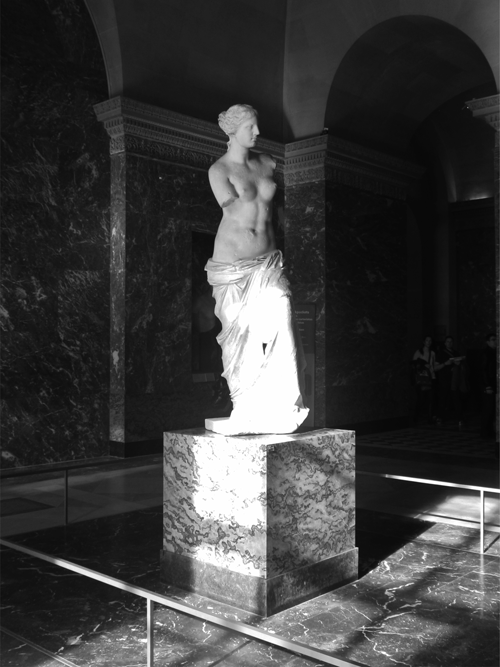
Once upon a time, the Aphrodite of Melos did, in fact, have arms, but they broke off at some point, as arms, noses, and legs often tend to do. The exact same thing has happened to many other sculptures’ noses. Because the noses stick out, they tend to break off easily.
Greek sculptures as we see them today are merely worn-out husks of their former glory. They were originally brightly painted, but most of the original pigments faded or flaked off long ago, leaving the bare, white marble exposed. Some exceptionally well-preserved sculptures do still retain traces of their original coloration, though.
Ever wonder why the Sphinx has no nose? Why many Ancient Egyptian artifacts are found without an arm, a nose, a head, or another body part? It’s not from wear and tear, or the natural damage of thousands of years, they were a calculated effort by Ancient Egyptians to strip the figure, god, or king of their power especially in the afterlife.

The destruction of statues, figurines, and paintings, known as iconoclasm, is the subject of a new exhibition in St. Louis, Missouri, USA, which will attempt to understand the cultural practice of defacing Ancient Egyptian monuments.
No matter if they were the former regime seeking to strip the power of those they overthrew, grave robbers looking to strip tombs of the valuables yet still feared the power of those that are dead, or even early Christians who wished to communicate the power of the new God over the pagan polytheists, all defaced monuments to thumb their nose at the gods, pharaohs, and ancient Egyptian elite.
When Set wished to destroy his brother Osiris, he could not kill an immortal god, so what to do? Dismember him, scatter his body parts across the country, and Osiris would no more be able to challenge his brother. This ritual formed the belief in Ancient Egyptians that dismemberment was the only means to break the power of the divine, an effort that needed to be undertaken for one reason or another over the centuries.

Ancient Egyptians believed that their mummies, monuments, and statues served as a vessel for divine energy to fill. When making offerings, it was thought that the deity would fill the statue in the home, temple, or necropolis, with the dead wielding just as much power as the living.
Edward Bleiberg states in his essay on iconoclasm that “Once the deity has occupied it, the sculpture or relief containing the god becomes a piece of equipment for conducting the essential rituals of offering and worship. The rituals performed with images center specifically on offering and receiving food, drink, clothing, and other necessities. Deceased kings and deceased humans were able to make such offerings to the gods in the afterlife by means of images placed in temples for that purpose. When a statue or image is disabled, it is sometimes clear that it is this particular purpose of the image that has been attacked.”
From time to time, a Pharaoh, elite, or great figure would fall out of favor. The biggest example being Hapshepsut who, along with her husband, attempted to create one god that stood above the other ancient deities. The Cult of Aten was a scandal for Ancient Egyptians, and after the Aten revolution was suppressed, the old regime systematically defaced every statue of Hatshepsut in the country as a means of weakening Aten.
Pharaohs were so anxious about their image being defaced that a royal decree passed in the First Intermediate Period stated that anyone who defaced a statue lost their right to a soul and a place in the afterlife.
Egyptologist Betsy Bryan has established that damaging a mummy as a means of attacking a person in the next world started in Egypt at the very beginning of its history, during the Pre-Dynastic period. This action was in fact analogous to the attacks on statues and reliefs that would occur in the historical period of Egyptian history.
In every era of the following three thousand years of ancient Egyptian history, there is good evidence that the practice of damaging images of the human form, as either protection from, or an attack on, perceived enemies, remained common.
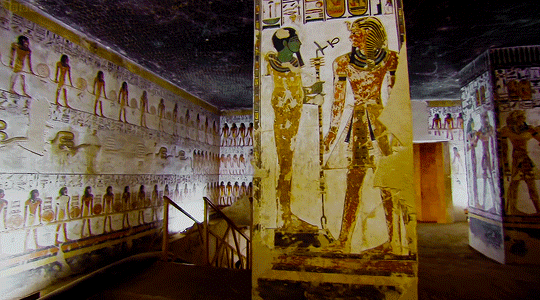
So, why the nose? And why not just break the statue into smithereens? For the Ancient Egyptians, the nose was essential in re-creating life after death. The incense placed in the nose allowed the breath of life to enter the soul of the deceased. When tomb-raiders destroyed and looted a tomb, they still feared the power of the pharaoh, so damaging the nose was an important way to avoid punishment. If the buried pharaoh couldn’t continue his life after death, he wouldn’t be a witness when those tomb-raiders were dead themselves.
Yet total destruction of a statue was regarded as less efficacious than partial damage, as many examples cited here show. In his late fourth- and early fifth-century CE preaching, Saint Augustine recommended partial breakage of polytheistic statues, saying, “Brethren, I deem it more shameful for Hercules to have his beard shaved than to have his head taken off.”

In this case, shaving Hercules’s beard was thought to show that his statue was powerless in the face of Christianity. The presence of damaged statues of Greek or Egyptian gods was understood to definitively demonstrate the power of Christianity and the helplessness of the gods of earlier polytheistic religions.
Thus, Christian monks in Egypt damaged the parts of the temples that had been dedicated for a deity or for ritual, damaging but not destroying. In a way, they updated the historical statues to reflect the times. While we in the modern-day see this as an attack on civilization, the early converts saw it and an enduring testament to the biggest revolution in spirituality up to that point; the transition from polytheism to monotheism and the ancient world to the pre-modern.
When the Christians of Egypt saw that the polytheistic Egyptians still made tributes and rituals in the sight of the Sphinx of Giza, they cracked off the nose to make the Sphinx eternally flawed and incomplete which was successful in breaking the true power that the Sphinx had over Egypt. Not even the Egyptians knew what the meaning and nature of the Sphinx was, it was the embodiment of enigma, mystery, secrets, and thus power and unity. Even today secrets have a psychological effect to bond people together. By breaking the nose, the mystic vanished. No retribution came. So the mystery of the Sphinx was revealed, that it had no true secret.
Bleiberg counters the idea that Muslims defaced these statues, saying it was far more likely the Christians as the Christians communicated the power of God by speaking the language of the pagans whereas Muslims just mined tombs, statues, and temples for valuable stones. Muslim conquerors were not interested in demonstrating to the pagans the greatness of God, they felt that the dismantling of Ancient Egypt for material concerns would demonstrate to the pagans what happens to a civilization that doesn’t keep the true god.

So, it many ways the Christians continued the same practice of the Ancient Egyptians, and mark a continuity of Egyptian customs under a new religious creed. The Christians would continue this concept through the medieval ages, with Constantinople carrying out an empire-wide iconoclasm numerous times. Even today we burn effigies and symbols of figures we hate as an attack on the image, and thus power, of the individual and system they represent. So, the practice of chiseling a nose off should not be a shock to us today.
I hope you enjoyed this blog,
Culture Calypso’s Blog
#my blogs#spirituality#history#paganism#religion#greek mythology#egyptology#giza#egyptian#greek and roman mythology#soundcloud#iconoclasm
1 note
·
View note
Text
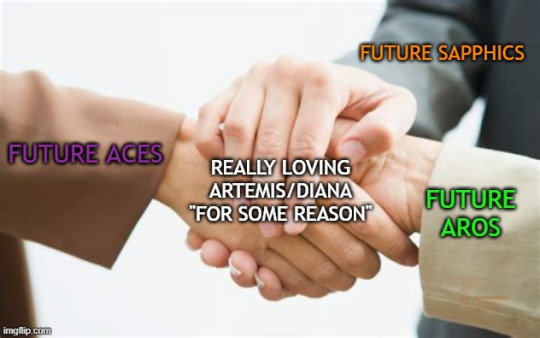
this can't be just me
#greek mythology#roman mythology#hellenic pantheon#hellenic mythology#artemis#diana#asexuality#aromantism#queer#ace memes#aro memes#sapphic#wlw
3K notes
·
View notes
Photo
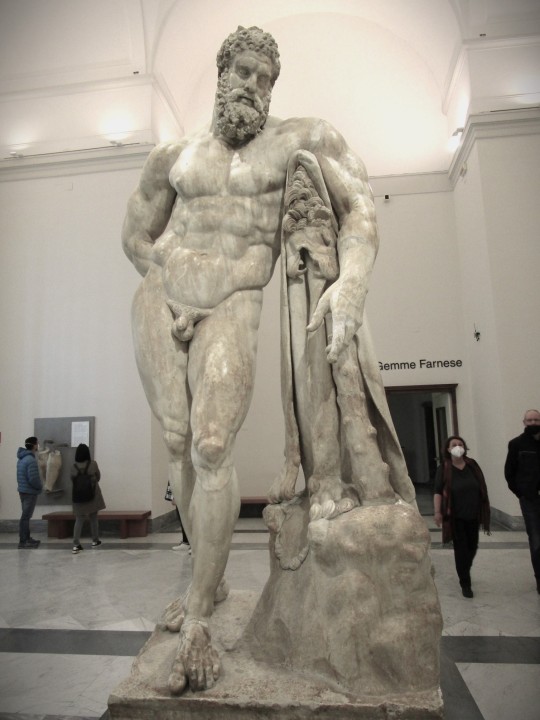

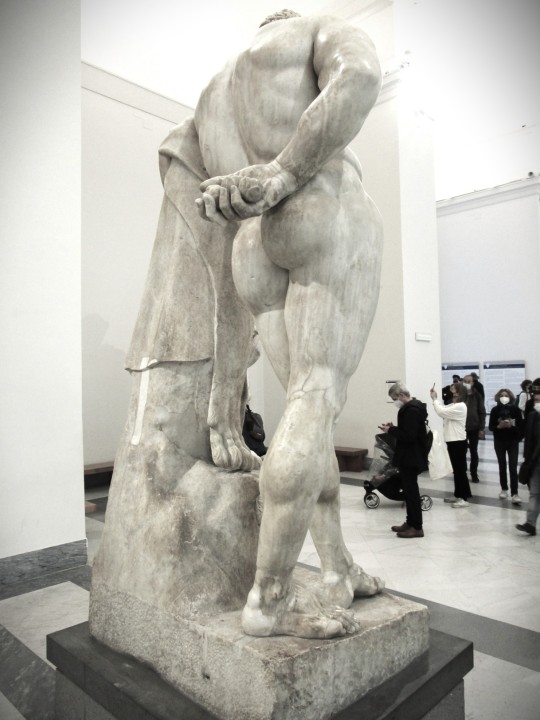

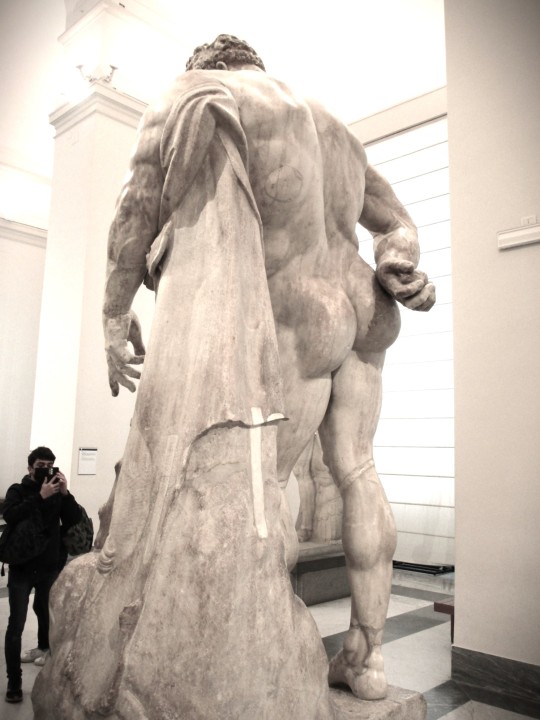

Hercules at Rest, late 2nd to early 3rd century CE Roman copy from a Greek original of the late 4th century BCE
Museo Archeologico Nazionale di Napoli
Often referred to as the “Farnese Hercules,” The massive statue depicts the powerfully built hero looking a little tired after completing the eleventh of his twelve labors. He holds the apples of the Hesperides in his right hand as he leans on his club.
Photos by Charles Reeza
#ancient art#classical antiquity#greek and roman mythology#muscular man#the definitive Hercules#this IS Hercules#marble statue#male nude#sculpture
125 notes
·
View notes
Link
I think this video highlights the skill of the Ancients and Renaissance sculptors - if it looks difficult by modern standards, imagining how the did it is all that more impressive. When we see sculptures in museums, the “head” artist is usually the only one attributed, but this demonstrates that there are many more heads and hands put together in order to create this, whether with today’s tech or in antiquity, et al.
I learned that a standard “pointing machine” (Pointing_machine) is not able to be used for enlarged or reduced copies of sculpture, but rather for one-to-one copies. Although, there are special pointing machines used for mirroring, enlargement, and reducing. Calipers are generally used to scale models up or down (source).
In the Frilli Gallery video (timestamp 3:22), you can see a sculptor using what looks to be the ‘3-caliper method’ to enlarge the sculpture. It is interesting to me that the marble barely looks anything like the original at this point. At many points of the video, you see a few different sculptors sing this method. To me, this raises the question of “who gets the credit?” Today, you’s expect the credit to be given to any who helped create, but that is not necessarily the case.
In ancient times, I’d expect this process to take infinitely longer. They had the caliper method, but per the article above, the pointing machine was not invented until the 18th century-ish. The Greeks and Romans had similar tools, but imagine having to hand carve the marble AFTER it was mined and carried/dragged to the workshop. It would have taken dozens of craftspeople to finish them. Know the little I do about the way the ancients copied their sculpture, no wonder they did that! To think that the market was so large back then is crazy knowing the “primitive” (I know that’s not the best word, but you get the idea) tools and methods they had. Honestly though, the methods don’t seem to have changed all that much besides silicone and electricity, but those really do help!
1 note
·
View note